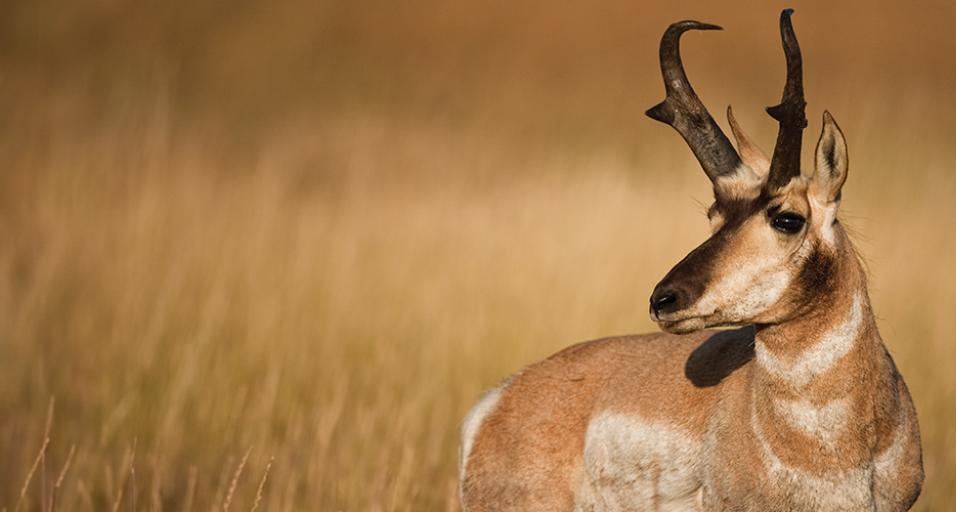Pronghorn, antelope, speed goat — the many names of a one-of-a-kind species. Pronghorn are native to North America and have no other family in the world. Wyoming is home to the largest number of pronghorn in North America — roughly 320,000*.
Male vs. Female pronghorn
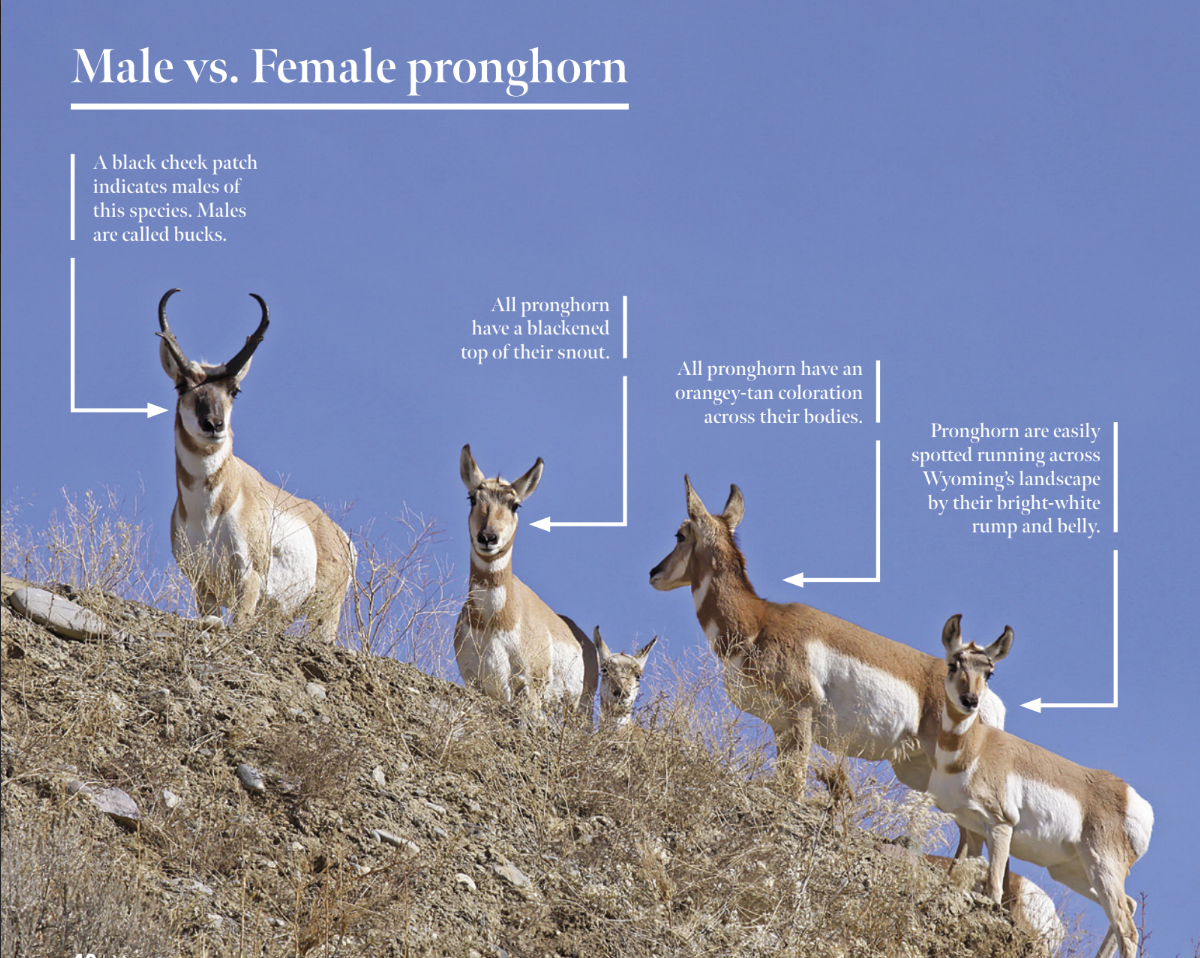
Do pronghorn grow antlers or horns?
The accessories growing on a pronghorn’s head may resemble an antler, branched or pronged and shed annually, however, pronghorn grow horns. Male and female pronghorn can grow horns, although the horns of males are larger and more pronounced. Pronghorn grow a new set of horns between November and March. Their horns begin to grow around a bony core called a prong found underneath their present set of horns. The prong is triangular-shaped, and the first sign of growth for the new set of horns starts at the tip. Over a few months, the growth will continue upward. When the new set of horns is fully formed, around early December, the current set of horns will fall off, revealing the new set of horns underneath. Humans have a similar experience. As children,we have baby teeth. As we age, our adult teeth start forming and growing within our gums, below our present baby teeth. Once the adult teeth are formed, they grow upward and require more space, causing our baby teeth to become wiggly and eventually fall out.
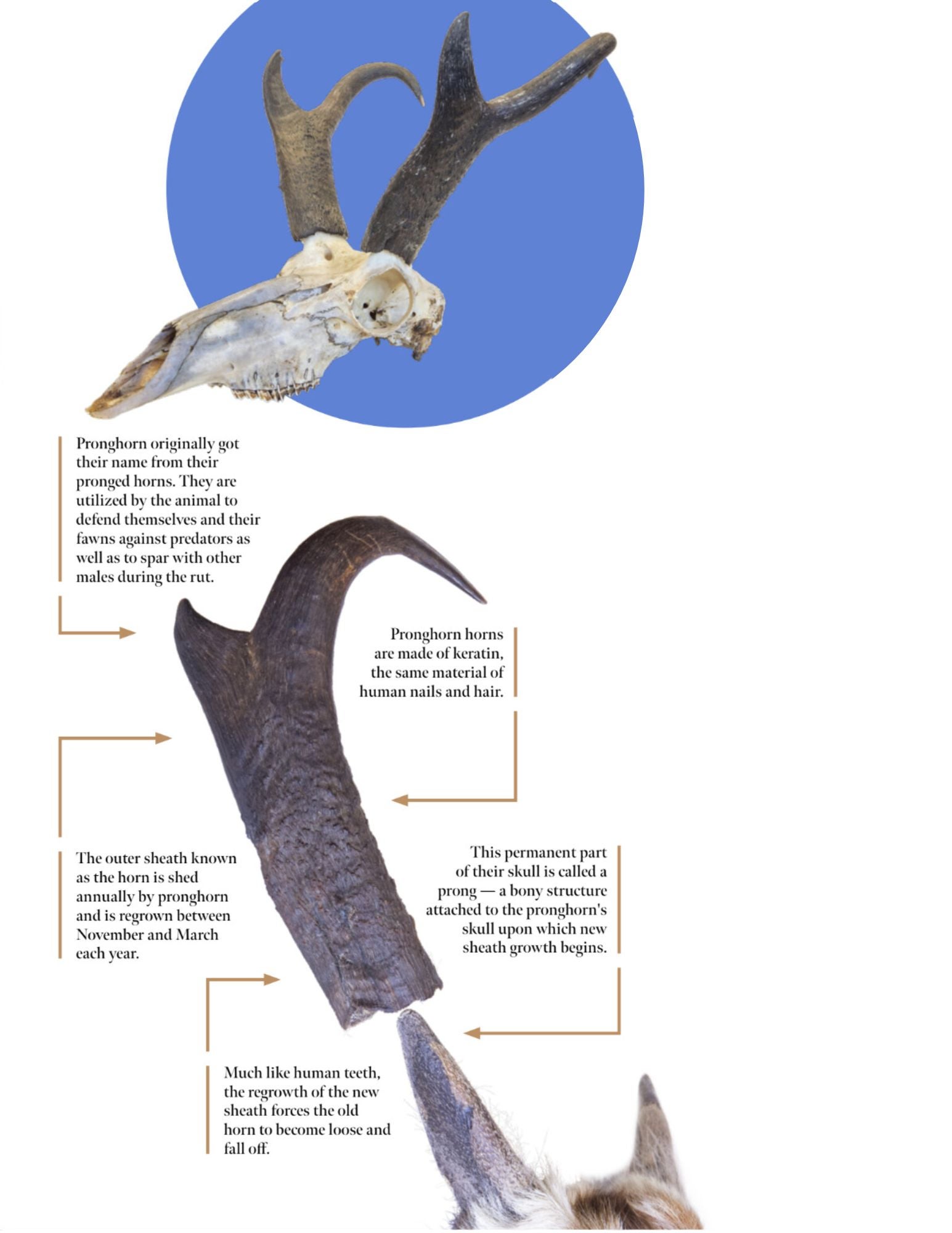
Who wins the race between a cheetah and pronghorn?
Did you know pronghorn can jump higher than the average house? This is possible because a house can’t jump. Pronghorn may not jump high, but they run really fast. How fast? Let’s compare the two fastest land mammals on earth. Pronghorn are the second-fastest mammal on earth, reaching up to 50 miles per hour and maintaining that speed for long distances. A cheetah can run 50-80 mph but can only keep that speed for roughly 30 seconds, or about 0.28 miles, before getting tired.
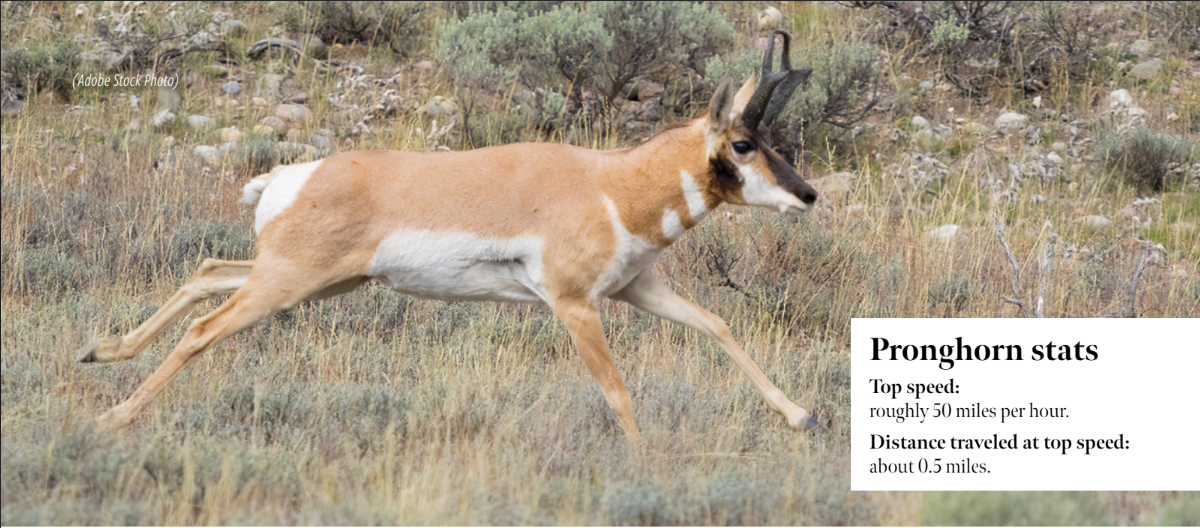
Pronghorn, however, can run at top speed for half-a-mile before running out of energy. Both are impressive, but we will leave it up to you to decide who would win a race. There may be debate whether a cheetah or pronghorn would win a race, but there’s no debate that a pronghorn will likely outpace any animal in North America. Pronghorn are leaps and bounds faster than any predator, like coyotes or mountain lions, that may hunt them. So, why did they adapt to be so fast? A fossil of a cat-like species was found in a cave in West Virginia. This finding sparked theories that a North American cat existed nearly 3 million years ago and may be the reason behind the pronghorn’s speed today. This high-speed cat likely preyed on pronghorn, causing them to adapt to outrun it. Unfortunately, we may never know the full truth. Pronghorn are mobile creatures and travel long distances. Every winter, pronghorn populations will migrate to a new location in search of resources, like food, water and shelter, to survive another season. Pronghorn have the longest land migration in the continental United States. Herds in Wyoming travel from Grand Teton National Park to the Upper Green River Basin, which is more than 150 miles each way. Pronghorn complete their migrations each spring and fall.
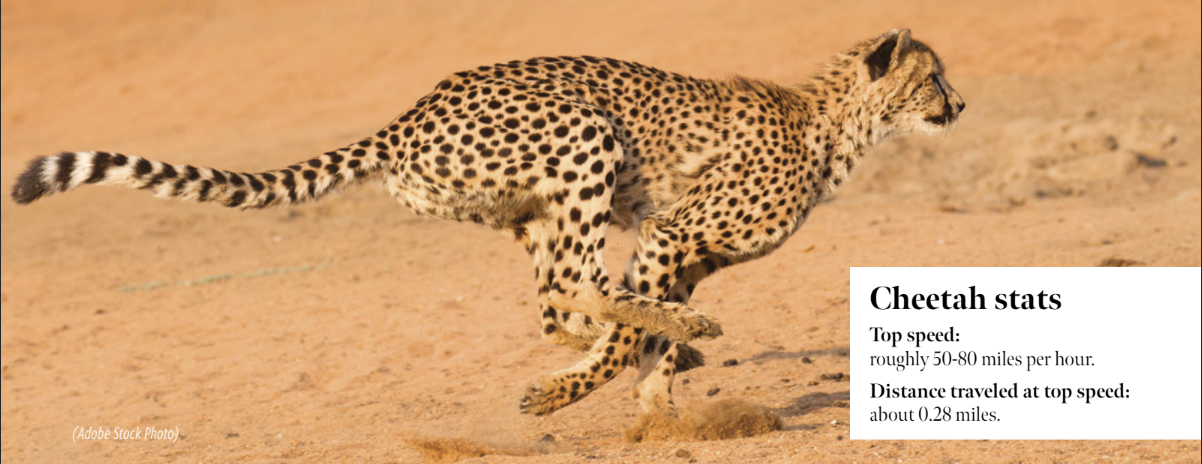
Diet, reproduction and habitat of Wyoming's pronghorn.
Pronghorn are herbivores and eat only plant matter like grasses, forbs, sagebrush and other plants. To better digest their meals, pronghorn digest their food twice. After first swallowing their food, it passes through their stomach and then pronghorn regurgitate it. Regurgitated food is called cud. You will rarely see a pronghorn drinking water. They are able to get enough water from the plants they eat. Pronghorn breed in late summer, usually in September. Pregnant females give birth to babies called fawns in late May or early June. Pronghorn usually give birth to twins. Fawns weigh between 5-7 pounds. Although small and weak, pronghorn are not defenseless to predators. Fawns are scentless and quickly gain the ability to run and evade predators shortly after birth. At just 5-days-old, fawns can outrun a human. Pronghorn prefer to live in flat areas with gentle, rolling hills. This terrain pairs well with their high-speed tactic of escaping predators.
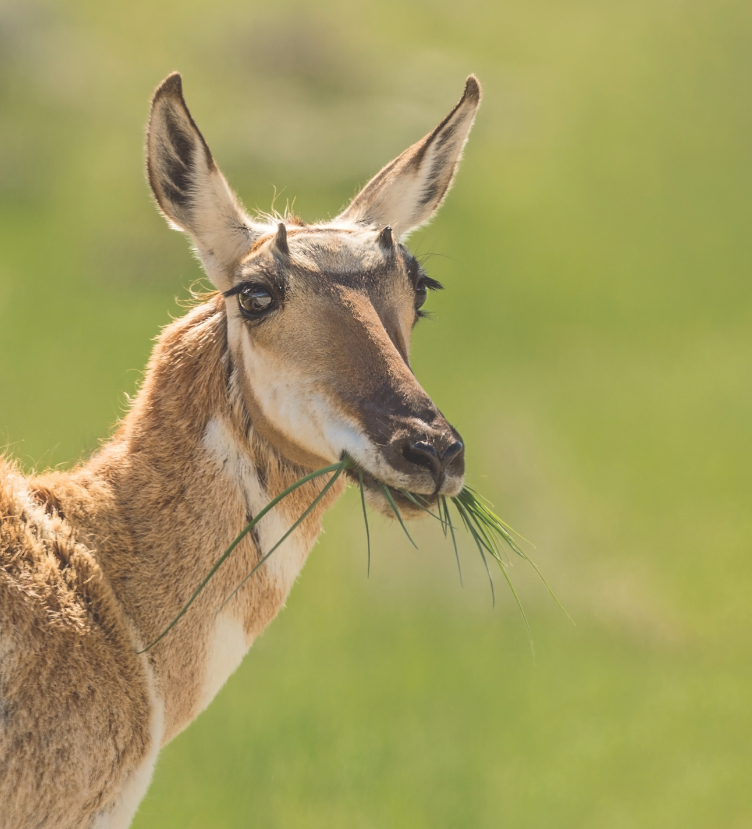
Did you know?
• Baby pronghorn are called fawns.
• Pronghorn fawns can run faster than humans within five days of birth.
• A pronghorn’s large liver allows them to eat poisonous plants.
• Pronghorn have the longest land migration in the continental United States, traveling up to 150 miles one way.
• Pronghorn get their name from the pronged horn they grow on their heads.
• Both male and female pronghorn grow horns.
• Pronghorn are the only living animal in the Antilocapra family.
• Pronghorn usually give birth to twins.
• Pronghorn can run up to 50 miles per hour. They are the second-fastest land mammal on earth.
• Male pronghorn are called bucks and females are does; similar to the deer family.
• Guard hairs on a pronghorn’s rump send signals to others when they become alarmed. These hairs will extend upward, making their white rumps more visible and telling other pronghorn danger may be near.
• Pronghorn reach their necessary water intake levels through the plants they eat, not from drinking water directly.
• Pronghorn’s wide-set eyes allow them to see a nearly 360-degree range. This helps them spot any nearby predators.
• Pronghorn cannot see the colors purple, red, pink or orange. This is why hunters can wear blaze orange and still sneak up on game.
• A group of pronghorn is called a herd or band.
• On average, pronghorn weigh 90-150 pounds.
• A pronghorn’s coloration helps it in its environment. Its white underbelly and neck deflect heat rising from the ground, and its outer layer of air-filled hairs keeps it warm in the winter.
• During the summer, pronghorn molt their outer layer of fur and make their hairs stand upright to stay cool.
• If a predator attacks, a pronghorn will use its horns and hooves to protect itself.
• When crossing a fence, a pronghorn usually crawls underneath instead of jumping over.
*EDITOR'S NOTE: A previous version of this article incorrectly stated the pronghorn population in Wyoming was around 500,000. This has been corrected to 320,000 to reflect most recent estimates.

